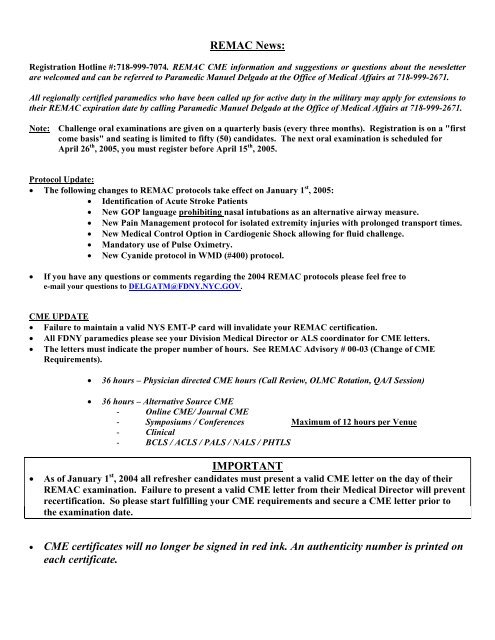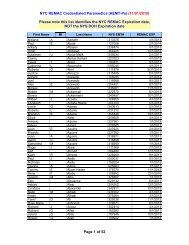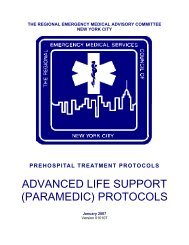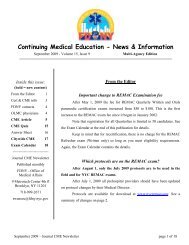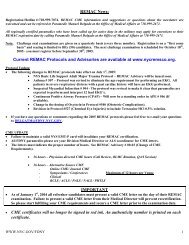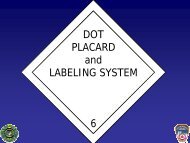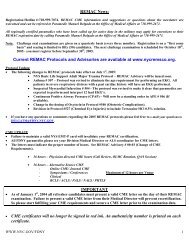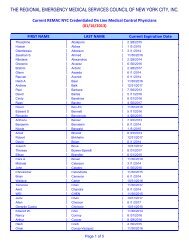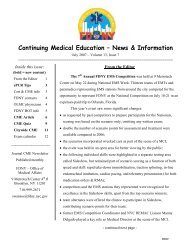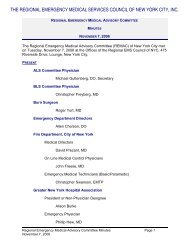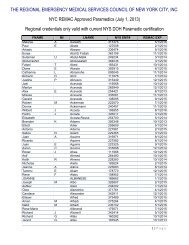nyc remac - The Regional Emergency Medical Services Council of ...
nyc remac - The Regional Emergency Medical Services Council of ...
nyc remac - The Regional Emergency Medical Services Council of ...
- No tags were found...
You also want an ePaper? Increase the reach of your titles
YUMPU automatically turns print PDFs into web optimized ePapers that Google loves.
In reviewing ePCRs in Division One for a thirty (30) day period, OMA conducted a study toidentify compliance in use <strong>of</strong> the 12 lead EKG in cardiac cases where ALS units responded. <strong>The</strong>following are the findings <strong>of</strong> this review.‣ Total patients over age 12 where “chest pain” or“cardiac symptoms” were indicated 35‣ Patients over age 12 where “chest pain” or “cardiacsymptoms” were indicated and received a 3 leadEKG 28‣ Patients over age 12 where “chest pain” or “cardiacsymptoms” were indicated and subsequentlyreceived a 12 lead EKG 27This review indicates good compliance with the ALS protocol in Division One keep up theexcellent work!• As a result <strong>of</strong> the Pulse Oximetry – QA Form sent into OMA by field paramedicsthe extension cable for the SpO 2 monitor will now be included in the cable packagefor the Life Pack 12. We will continue to accept Pulse Oximetry – QA Forms untilFebruary 6 th , 2005. EMS Operations and the Office <strong>of</strong> <strong>Medical</strong> Affairs would like tothank you for your continued cooperation and support. Keep up the great work!
NYC REMACAdvisory No. 2004-16Title: Identification <strong>of</strong> ACUTE Stroke PatientsTransport to NYS DOH Designated Stroke CentersIssue Date: December 6, 2004Effective Date: ImmediatelySupercedes: N/A Page: 1 <strong>of</strong> 5<strong>The</strong> <strong>Regional</strong> <strong>Emergency</strong> <strong>Medical</strong> Advisory Committee (REMAC) <strong>of</strong> New York City has been advised that the New York StateDepartment <strong>of</strong> Health is now designating Stroke Centers for the care <strong>of</strong> patients identified as having suffered an “Acute Stroke”. Thisadvisory contains information to properly identify and transport “Acute Stroke” patients to appropriate facilities.With the permission <strong>of</strong> FDNY, this advisory contains information excerpted from:‣ Office <strong>of</strong> <strong>Medical</strong> Affairs Directive 2004-18 (November 18, 2004) – Prehospital Evaluation <strong>of</strong> Stroke Center Candidates‣ EMSC OGP 115-10 (November 18, 2004) – Prehospital Identification <strong>of</strong> Stroke Center Candidates‣ EMSC OGP 115-10, APPENDIX A (November 18, 2004) – Using the Prehospital Stroke ScaleFDNY information has been modified for use by non-FDNY/911 System ParticipantsOwners/operators <strong>of</strong> Ambulance and ALS First Response <strong>Services</strong> providing prehospital medical treatment within the fiveboroughs <strong>of</strong> the City <strong>of</strong> New York are responsible to ensure their Service <strong>Medical</strong> Directors and EMS PrehospitalProviders are informed <strong>of</strong> all changes/updates to the NYC REMAC Prehospital Treatment Protocols.Lewis W. Marshall, Jr., MD, JDChair<strong>Regional</strong> <strong>Emergency</strong> <strong>Medical</strong> Advisory Committee <strong>of</strong> New York City
NYC REMACAdvisory No. 2004-17Title: ALS Protocol # 504-BCardiogenic ShockIssue Date: December 6, 2004Effective Date: January 1, 2005Re-Issued: N/ASupercedes: Protocol Issued July 1, 2004 Page: 1 <strong>of</strong> 2<strong>The</strong> <strong>Regional</strong> <strong>Emergency</strong> <strong>Medical</strong> Advisory Committee (REMAC) <strong>of</strong> New York City has revised the Advanced Life Support Protocol504-B: Cardiogenic Shock. <strong>The</strong> revision is limited to the addition <strong>of</strong> the administration <strong>of</strong> a fluid challenge prior to theadministration <strong>of</strong> Dopamine.<strong>The</strong> following changes were made:New <strong>Medical</strong> Control Option has been added, as follows: (New language is double-underscored and bold)MEDICAL CONTROL OPTIONS:OPTION A:Administer a 250 ml IV bolus <strong>of</strong> Normal Saline (0.9% NS). Repeat once for a maximum total dose <strong>of</strong> 500 ml.Remaining <strong>Medical</strong> Control Options will be re-numbered accordingly.A copy <strong>of</strong> the revised protocol is attached.Owners/operators <strong>of</strong> Ambulance and ALS First Response <strong>Services</strong> providing prehospital medical treatment withinthe five boroughs <strong>of</strong> the City <strong>of</strong> New York are responsible to provide copies <strong>of</strong> the NYC REMAC PrehospitalTreatment Protocols to their personnel, and to ensure that Service <strong>Medical</strong> Directors and EMS personnel areinformed <strong>of</strong> all changes/updates to the NYC REMAC Prehospital Treatment Protocols.This revised protocol revision will be effective January 1, 2005.Lewis W. Marshall, Jr., MD, JDChair<strong>Regional</strong> <strong>Emergency</strong> <strong>Medical</strong> Advisory Committee <strong>of</strong> New York City
504-BCARDIOGENIC SHOCKEffective Date: January 1, 20051. Contact <strong>Medical</strong> Control for implementation <strong>of</strong> one or more <strong>of</strong> the following MEDICAL CONTROL OPTIONS:MEDICAL CONTROL OPTIONS:OPTION A:OPTION B:OPTION C:Administer a 250 ml IV bolus <strong>of</strong> Normal Saline (0.9% NS). Repeat once for a maximum total dose <strong>of</strong> 500 ml.Administer Dopamine 5 ug/kg/min, IV/Saline Lock drip. If there is insufficient improvement in hemodynamic status, theinfusion rate may be increased until the desired therapeutic effects are achieved or adverse effects appear. (Maximum dosageis 20 ug/kg/min, IV/Saline Lock drip.)Transportation Decision.WWW.NYC.GOV/FDNY 8
NYC REMACAdvisory No. 2004-18Title: General Operating ProceduresAirway Management – Nasal IntubationIssue Date: December 6, 2004Effective Date: January 1, 2005Re-Issued: N/ASupercedes: N/A Page: 1 <strong>of</strong> 1<strong>The</strong> <strong>Regional</strong> <strong>Emergency</strong> <strong>Medical</strong> Advisory Committee (REMAC) <strong>of</strong> New York City has revised the Airway Managementsection <strong>of</strong> the General Operating Procedures to clearly state that nasal intubation is an unacceptable form <strong>of</strong> airway managementin the prehospital environment. This mandate is effective January 1, 2005.<strong>The</strong> following changes were made:<strong>The</strong> Airway Management section <strong>of</strong> the Prehospital Treatment Protocols – General Operating Procedures has been updated, asfollows: (New language is double-underscored and bold)AIRWAY MANAGEMENTAll patients require continuous monitoring <strong>of</strong> their airways to ensure airway patency. Wherever the term "Monitor airway" is usedthroughout these protocols, the following elements shall be utilized:• Position <strong>of</strong> the patient's head• Need for airway adjuncts• Need for oropharyngeal suctioning;• Need for Advanced Life Support airway management techniques• Use <strong>of</strong> Pulse Oximetry (S p O 2 ) ‘if available’• Use <strong>of</strong> secondary form <strong>of</strong> Endotracheal Tube confirmation (Example: End Tidal Capnography (ETCO 2 ). Secondaryconfirmation devices are not a substitute for primary confirmation techniques that rely upon direct visualization andauscultation, but serve as an additional method <strong>of</strong> documenting proper endotracheal tube placement.NOTE:NASAL INTUBATION IS CONSIDERED TO BE AN UNACCEPTABLE FORM OF AIRWAYMANAGEMENT WITHIN THE NEW YORK CITY REGION.Owners/operators <strong>of</strong> Ambulance and ALS First Response <strong>Services</strong> providing prehospital medical treatment within the fiveboroughs <strong>of</strong> the City <strong>of</strong> New York are responsible to ensure their Service <strong>Medical</strong> Directors and EMS personnel are informed <strong>of</strong>all changes/updates to the NYC REMAC Prehospital Treatment Protocols.Lewis W. Marshall, Jr., MD, JDChair, <strong>Regional</strong> <strong>Emergency</strong> <strong>Medical</strong> Advisory Committee <strong>of</strong> New York CityWWW.NYC.GOV/FDNY 9
NYC REMACAdvisory No. 2004-19Title: NEW Advanced Life Support Protocol529: Pain ManagementIssue Date: December 6, 2004Effective Date: January 1, 2005Re-Issued: N/ASupercedes: N/A Page: 1 <strong>of</strong> 2<strong>The</strong> <strong>Regional</strong> <strong>Emergency</strong> <strong>Medical</strong> Advisory Committee (REMAC) <strong>of</strong> New York City has developed a NEW Advanced Life Support Protocolfor the management <strong>of</strong> pain. Implementation <strong>of</strong> this protocol is limited to patients with isolated extremity injuries, in cases with prolongedscene/transport time. Head injury is a contraindication for implementation <strong>of</strong> this protocol.A copy <strong>of</strong> the New ALS Protocol # 529 – Pain Management protocol is attached.Owners/operators <strong>of</strong> Ambulance and ALS First Response <strong>Services</strong> providing prehospital medical treatment within the fiveboroughs <strong>of</strong> the City <strong>of</strong> New York are responsible to provide copies <strong>of</strong> the NYC REMAC Prehospital Treatment Protocolsto their personnel, and to ensure that Service <strong>Medical</strong> Directors and EMS personnel are informed <strong>of</strong> all changes/updates tothe NYC REMAC Prehospital Treatment Protocols.This revised protocol revision will be effective January 1, 2005.Lewis W. Marshall, Jr., MD, JDChair<strong>Regional</strong> <strong>Emergency</strong> <strong>Medical</strong> Advisory Committee <strong>of</strong> New York CityWWW.NYC.GOV/FDNY 10
529PAIN MANAGEMENT FOR ISOLATED EXTREMITY INJURYEffective Date: January 1 st , 2005For patients with isolated extremity injury, if there is severe pain with prolonged scene/transport time1. Begin Basic Life Support Procedures.2. Begin cardiac monitoring. Record and evaluate rhythm strip.3. Begin pulse Oximetry monitoring (if available).4. Begin an IV/Saline Lock infusion <strong>of</strong> Normal Saline (0.9% NS) at a KVO rate.5. Monitor vital signs every 5 minutes.6. If there is severe pain with prolonged scene/transport time, contact <strong>Medical</strong> Control for implementation <strong>of</strong> one or more <strong>of</strong> the followingMEDICAL CONTROL OPTIONS:MEDICAL CONTROL OPTIONS:OPTION A:Administer Morphine Sulfate 2 – 5 mg, IV/Saline Lock bolus. Repeat doses <strong>of</strong> Morphine Sulfate 2 – 5 mg IV/Saline Lockbolus, may be given as necessary. (Maximum total dosage is 15 mg.)NOTE:IF HYPOTENSION, HYPOVENTILATION, OR STUPOR DEVELOPS, WITHHOLD MORPHINE SULFATE,ELEVATE THE LEGS, AND ADMINISTER NALOXONE 2 MG, IV/SALINE LOCK BOLUS.WWW.NYC.GOV/FDNY 11
NYC REMACAdvisory No. 2004-20Title: General Operating ProceduresAirway ManagementMANDATORY USE OF PULSE OXIMETRYIssue Date: December 6, 2004Effective Date: July 1, 2005Re-Issued: N/ASupercedes: N/A Page: 1 <strong>of</strong> 1<strong>The</strong> <strong>Regional</strong> <strong>Emergency</strong> <strong>Medical</strong> Advisory Committee (REMAC) <strong>of</strong> New York City, in order to maintain optimal standard <strong>of</strong>care protocols, has made the use <strong>of</strong> Pulse Oximetry mandatory as part <strong>of</strong> the Advanced Life Support protocols. Use <strong>of</strong> PulseOximetry remains optional for Basic Life Support. This mandate is effective July 1, 2005.<strong>The</strong> following changes were made:<strong>The</strong> Airway Management section <strong>of</strong> the Prehospital Treatment Protocols – General Operating Procedures has been updated, asfollows: (Deleted language is struck-out, new language is double-underscored)AIRWAY MANAGEMENTAll patients require continuous monitoring <strong>of</strong> their airways to ensure airway patency. Wherever the term "Monitor airway" is usedthroughout these protocols, the following elements shall be utilized:• Position <strong>of</strong> the patient's head• Need for airway adjuncts• Need for oropharyngeal suctioning;• Need for Advanced Life Support airway management techniques• Use <strong>of</strong> Pulse Oximetry (S p O 2 ) ‘if available’:• Mandatory for Advanced Life Support• Optional for Basic Life Support• Use <strong>of</strong> secondary form <strong>of</strong> Endotracheal Tube confirmation (Example: End Tidal Capnography (ETCO 2 ). Secondaryconfirmation devices are not a substitute for primary confirmation techniques that rely upon direct visualization andauscultation, but serve as an additional method <strong>of</strong> documenting proper endotracheal tube placement.NOTE:NASAL INTUBATION IS NOT CONSIDERED TO BE AN ACCEPTABLE FORM OF AIRWAYMANAGEMENT WITHIN THE NEW YORK CITY REGION.Owners/operators <strong>of</strong> Ambulance and ALS First Response <strong>Services</strong> providing prehospital medical treatment within the fiveboroughs <strong>of</strong> the City <strong>of</strong> New York are responsible to ensure their Service <strong>Medical</strong> Directors and EMS personnel are informed <strong>of</strong>all changes/updates to the NYC REMAC Prehospital Treatment Protocols.Lewis W. Marshall, Jr., MD, JDChair, <strong>Regional</strong> <strong>Emergency</strong> <strong>Medical</strong> Advisory Committee <strong>of</strong> New York CityWWW.NYC.GOV/FDNY 12
FEEDBACKThank you for participating in the Journal CME program. <strong>The</strong> response so far has been terrific, with over 6000certificates for ONE HOUR <strong>of</strong> CME credit issued thus far. As we present this month’s edition, we would like to hear fromyou. Please take a moment to answer a few questions and return them with your CME answer sheet. Thank you for yoursupport and we look forward to sending you this month's completion certificate.Journal CME StaffPlease Print!Are you enjoying the Journal CME program? _______________________If not, why?__________________________________________________________________________________________________________________________________________________________Do you find the articles informative and educational? _______________What topics would you like to see addressed in the future?_________________________________________________________________________________________________________________________________________________________________________________________________________________________________Your comments and ideas are greatly appreciated:_______________________________________________________________________________________________________________________________________________________________________________________________________________________________________WWW.NYC.GOV/FDNY 13
Paramedics are encouraged to read the article ("Radiation Part Four" written by Dario Gonzalez, MD) and then answer thefollowing 10 questions on the answer sheet below. Paramedics receiving a minimum grade <strong>of</strong> 80% will receive (1) one hour <strong>of</strong>Online/Journal CME. Forward the completed answer sheet by Department Mail to theFDNY Office <strong>of</strong> <strong>Medical</strong> Affairs – ATTN. Paramedic Steven GoldsteinOr FAX (718) 999-0119Or U.S. MAIL 9 MetroTech Center, Brooklyn, N.Y. 11201-3857Participants are strongly advised to keep a copy <strong>of</strong> their submitted question sheets for their own record.• Please submit the CME answer sheet only once, please DO NOT fax it if you've sent it via e-mail or inter-<strong>of</strong>fice mail (pony express).NAME: ___________________________MAC#:_________BATT# / HOSP AFFILIATION: ______________E-MAIL ADDRESS: ______________________________________HOME ADDRESS: ____________________________________________________________________________WWW.NYC.GOV/FDNY 14
Radiation Trilogy Part FourTransport Incident:You are assigned to a MCI 32 involving a truck and a school bus.<strong>The</strong> text identifies multiple injured children and overturned tractortrailer. As you approach the location you note multiple rescuepersonnel on scene including many ambulatory victims. As youapproach the bus you note that the involved truck has been tapped <strong>of</strong>fwith barrier tape. You also note this placard; additionally there is nonoted leakage from the truck payload.Transport Incident Potential:<strong>The</strong> risks associated with a range <strong>of</strong> different types <strong>of</strong> shipment <strong>of</strong> radioactive material, focusing on the transport <strong>of</strong> used fuel from powerplants, which accounts for the bulk <strong>of</strong> the radioactive inventory transported each year. Currently the U.S. has about 47,500 metric tons <strong>of</strong> spentnuclear waste stored in 43 states. It is projected that by 2040, there will be 108,000 metric tons <strong>of</strong> spent nuclear waste. For the long term, onsitestorage is not an efficient method. Risks can include leaks and destruction <strong>of</strong> waste storage containers by natural disasters and terroristattacks. Shipping would (is) via trucks, trains and barges carrying irradiated nuclear fuel and high/low-level radioactive waste. To date therehave been ~ 2,500 to 3,000 irradiated nuclear fuel shipments U.S. for well over 50 years. Each truck-sized container would hold up to 40 timesthe long-lasting radioactivity released by the Hiroshima atomic bomb. <strong>The</strong> much larger train/barge containers would each hold over 200 timesHiroshima’s long-lasting radioactivity. As with all commercial shipping the potential for accidents is always present. Even a fraction <strong>of</strong> a singleshipping container’s radioactive cargo escaping into the environment could prove catastrophic consequences for an area downwind anddownstream. <strong>The</strong> shipment containers are also theoretically vulnerable to terrorist attack, thus making them potential targets.RADIATION BASICS“<strong>The</strong>re is no safe level <strong>of</strong> exposure and there is no dose <strong>of</strong> (ionizing) radiation so low that the risk <strong>of</strong> a malignancy is zero”; therefore cautionand understanding <strong>of</strong> the risks are critical.WHAT IS RADIATION: Radiation is energy that travels in waves (i.e. visible light, ultraviolet light, radio waves). Non-ionizing radiation canshake or move molecules. Ionizing radiation can break molecular bonds, causing unpredictable chemical reactions. This includes energy wavesand particles. You cannot see, feel, taste, smell or hear ionizing radiation.WHERE DOES IONIZING RADIATION COME FROM: Ionizing radiation is matter or energy that is given <strong>of</strong>f by the nucleus <strong>of</strong> an unstableatom in the process <strong>of</strong> decaying and reaching a stable (ground) state. This energy is released in the form <strong>of</strong> alpha and beta particles or gammaand x rays waves.TYPES OF RADIATION:Alpha particles are high energy, large subatomic structures. <strong>The</strong>y cannot travel very far but can be stopped by a piece <strong>of</strong> paper or skin. Alphaparticles hit hard and can do a great deal <strong>of</strong> damage to cells. If inhaled, ingested, or injected into the body (through a break in the skin), theycan release energy to cells in organs or blood to surrounding tissue causing significant damage. A track <strong>of</strong> an alpha particle can deliver a largedose <strong>of</strong> radiation to cells along that line <strong>of</strong> travel. Alpha emitters include Plutonium, radon gas, uranium, and americium (smoke detectors).Beta particles are electrons. <strong>The</strong>y are smaller than the alpha particles, can travel farther and are more penetrating. Betas pose an internal andexternal body risk, depending on their energy level. External exposure can result in beta penetration through the surface to the most sensitivelayers <strong>of</strong> skin. Inhalation or ingestion <strong>of</strong> beta emitting substances poses the greatest risk. Externally, a ½ inch <strong>of</strong> Plexiglas or water can stop abeta particle. Strontium-90 and tritium are beta emitters; these are <strong>of</strong>ten byproducts <strong>of</strong> nuclear power reactors during normal operations.Physiologically Strontium-90 can be mistaken for calcium by the body and concentrated in bones (location for blood cell production). Thisincreases the risk <strong>of</strong> bone and blood cancers (leukemia). Many people probably have some strontium-90 in their bodies as a result <strong>of</strong> nuclearbomb testing. Gamma rays are the most penetrating type <strong>of</strong> radiation and can be stopped only by thick lead or concrete shielding. Cesium-137is a gamma emitter <strong>of</strong>ten released from nuclear reactors. It mimics potassium, and may be collected in muscle. Iodine-131/129 are also gamma-WWW.NYC.GOV/FDNY 15
emitters released through bomb testing and at nuclear reactor plants. Radioactive iodines collect in the thyroid gland (emitting beta and gammaradiation to surrounding tissue) and may result in thyroid cancer. X-rays are like gamma rays except they are most <strong>of</strong>ten generated electricallyby a machine. X-rays are normally used for medical or industrial diagnostic procedures and requires lead shielding.HALF-LIVES (T ½ ) AND DECAY CHAINS: Half-life is the time it takes for ½ <strong>of</strong> a radioactive element to decay (toward stability). Someradionuclides decay to a stable element in a relatively short time or like uranium, stability may be a long, complex process. Uranium-238 has aT ½ <strong>of</strong> 4.5 billion years, 17 decay steps, before reaching a final, stable form <strong>of</strong> lead. Half-lives can range from fractions <strong>of</strong> seconds (Polonium-214, .00016 seconds), to days (Iodine-131, 8.04 days) to billions <strong>of</strong> years. It is also possible for a radionuclide to decay to another radioactiveelement that has a longer half-life than the original radionuclide. Xenon-135, which is regularly produced by nuclear reactors, (9-hour half-life)decays to Cesium-135 with a half-life <strong>of</strong> 3 million years. Xenon-135’s hazardous life is defined as 10-20 times the half-life. This is how long itwill take for a given quantity <strong>of</strong> the radioactive element to decay to undetectable levels. Some radioactive atoms may give <strong>of</strong>f more than onetype <strong>of</strong> radiation. Radium for instance (which can collect and concentrate in humans), gives <strong>of</strong>f gamma and alpha radiation. This nucleotidewas implicated in the death <strong>of</strong> Madame Curie, the discoverer <strong>of</strong> Radium (by inducing an aplastic anemia). Children and the developing fetusare especially susceptible because <strong>of</strong> their rapid cell division during growth. Cancers linked to ionizing radiation include most blood cancers(leukemia), lung cancer, and many solid tumors <strong>of</strong> various organs. Birth defects have also been associated with radiation exposure. Radiationmay permanently and unpredictably mutate the human gene pool.What is radioactive waste?Radioactive waste is the unusable byproduct from using, refining, and processing radioactive materials, and from decommissioning equipmentand facilities that use those materials. Radioactive (or nuclear) waste is a byproduct from nuclear reactors, fuel processing plants, andinstitutions such as hospitals and research facilities. It also results from the decommissioning <strong>of</strong> nuclear reactors and other nuclear facilities thatare permanently shut down. <strong>The</strong> Nuclear Regulatory Commission separates wastes into two broad classifications: high-level or low-levelwaste. High-level radioactive waste results primarily from the fuel used by reactors to produce electricity. Low-level radioactive waste resultsfrom reactor operations and from medical, academic, industrial, and other commercial uses. Spent (used) nuclear reactor fuel (rods) resultsfrom producing electricity at nuclear power plants (Indian Point) or research reactors, after the usable fuel has been expended, highlyradioactive fuel assemblies remain. Spent fuel is shipped as a solid and is packaged in specially designed containers called "casks" for transport(see below). <strong>The</strong> spent nuclear fuel results in high-level waste after reprocessing resulting in the recovery <strong>of</strong> usable radioactive materials. Highlevelwaste includes liquid waste produced directly during reprocessing and solid material derived from such liquid waste that contains fissionproducts. <strong>The</strong> United States does not presently reprocess spent fuel from power plants, but has in the past. This requires their transport (incasks) to extended storage facility (Yucca Mountain).Transuranic waste contains manmade elements heavier than uranium, thus the name trans (or beyond) uranic. It results from defense productionactivities and includes contaminated protective clothing, tools, glassware, and equipment. Although most transuranic waste is no moreradioactive than low-level waste, it is radioactive for a much longer period <strong>of</strong> time.Types <strong>of</strong> Radioactive Waste<strong>The</strong> following is generally accepted terminology:• Exempt waste - excluded from regulatory control because radiological hazards are negligible.• Low-level waste (LLW) - contains enough radioactive material to require action for the protection <strong>of</strong> people, but not so much that itrequires shielding in handling or storage.• Intermediate-level waste (ILW) - requires shielding. If it has more than 4000 Bq/g <strong>of</strong> long-lived (over 30 year half-life) alpha emittersit is categorized as "long-lived" and requires more sophisticated handling and disposal.• High-level waste (HLW) - sufficiently radioactive to require both shielding and cooling, generates >2 kW/m 3 <strong>of</strong> heat and has a highlevel <strong>of</strong> long-lived alpha-emitting isotopes.Low level nuclear waste represents about 90% <strong>of</strong> all radioactive wastes. It includes ordinary items, such as cloth, bottles, plastic, wipes, etc.that come into contact with some radiation. <strong>The</strong>se low level wastes are generated anywhere radioisotopes are produced or used such as nuclearpower plants, local hospitals and dentist's <strong>of</strong>fice, in university research laboratories, in manufacturing and food irradiation facilities. It is notdangerous to handle, and can easily be disposed <strong>of</strong>f in a dry engineered landfill. <strong>The</strong>re, low level wastes are less dangerous than the chemicaland organic wastes from our homes that are sent to municipal landfills. <strong>The</strong> distinguishing factor <strong>of</strong> low-level waste is that it contains virtuallyno alpha emitters. Alpha radiation is more dangerous, and, therefore, needs better protection. For regulatory purposes, low level wastes areclassified into three classes (A, B, and C), according to the activity <strong>of</strong> the waste, the concentration, and the types <strong>of</strong> radioisotopes it contains.<strong>The</strong> Nuclear Regulatory Commission has set requirements for each type, so that they are disposed properly and safely. Class A (about 95% <strong>of</strong>all low level waste), contains radionuclides with the lowest concentrations and the shortest half-lives. Classes B and C contain greaterconcentrations <strong>of</strong> radionuclides with longer half-lives, and must meet stricter disposal requirements than Class A waste.Low-Level Radioactive Waste: Federal regulations require that nuclear waste be solid and structurally stable so that it can be transportedmore. Waste that meets these requirements reduces the risk <strong>of</strong> radiation exposure to humans. Low-level radioactive waste is generated in solidor liquid forms. Very little <strong>of</strong> it is structurally stable. <strong>The</strong>refore, the waste must be converted to an acceptable form for disposal. Low-levelradioactive waste is also treated to reduce its volume. While treatments can reduce the volume <strong>of</strong> low-level waste, the amount <strong>of</strong> radioactivematerial present remains essentially unchanged.WWW.NYC.GOV/FDNY 16
Compacting Low-Level RadioactiveWasteSolid Low-Level Radioactive Waste: Most <strong>of</strong> the low-level radioactive waste generated by nuclear power plants, industry, hospitals, andresearch institutions is in dry, solid form (such as cardboard, paper, plastic, cloth, and glass). To reduce the amount <strong>of</strong> space required to storethe low-level waste, three processes are used to reduce its volume: compaction, incineration, and shredding.Compaction involves compressing the waste to reduce its volume. Compaction is a relatively inexpensive and widely available option, which isused by many low-level radioactive waste generators.Incineration can be used to reduce the volume <strong>of</strong> solid low-level radioactive waste. This produces gases and ash radioactive particles. <strong>The</strong> gasis filtered to remove radioactive particles. <strong>The</strong> filters become contaminated and must be treated as radioactive waste. <strong>The</strong> ash is mixed withconcrete or other material to prevent radioactive particles from blowing away. Compaction and incineration are performed in conjunction withshredding. Shredding involves cutting solid low-level radioactive waste into smaller pieces. This allows for more efficient compaction and amore uniform burn for incineration. Any non-radioactive trash that is put in a container with radioactive waste must also be treated asradioactive waste because it might have become contaminated.Liquid Low-Level Radioactive Waste: Liquid low-level radioactive waste is generated primarily by nuclear power plants during purification<strong>of</strong> cooling water as well as lubricating oil and sludge’s from filters. Liquid low-level radioactive waste must be solidified for transportation anddisposal. Usually, as much water as possible is removed from the liquid waste, and the remaining material is immobilized. Methods forremoving water include evaporation and filtration. <strong>The</strong> remaining material is immobilized with solidifying agents such as cement or asphalt.<strong>The</strong> cement or asphalt is in a structurally stable form which can then be sent to a disposal facility.Short-Lived Low-Level Radioactive Waste: <strong>Medical</strong> facilities produce both solid and liquid low-level radioactive waste. That is, they decayquite quickly. Some wastes are stored in a container at the hospital until they decay (depends on the half-life <strong>of</strong> the radioactive materials). Afterthe wastes are analyzed for radioactivity to confirm that they have decayed, they can be disposed <strong>of</strong> as ordinary trash. This method <strong>of</strong> handlinglow-level waste is called storage for decay. It reduces the volume <strong>of</strong> waste to be sent to a low-level waste disposal facility. Low-levelradioactive waste stability requirements and the rapidly rising cost <strong>of</strong> disposal have encouraged widespread treatment <strong>of</strong> waste and substantialreductions in volume. In 1981, 2,960,000 cubic feet <strong>of</strong> commercial low-level radioactive waste were accepted for disposal in the United States.Ten years later, in 1991, the amount <strong>of</strong> waste accepted for disposal had declined 54% to 1,369,303 cubic feet.High Level Waste:High-level radioactive waste is uranium fuel that has been used in a nuclear power reactor and is “spent” or is no longer efficient in generatingpower to the reactor to produce electricity. Spent fuel is thermally hot as well as being highly radioactive, requiring remote handling andshielding. <strong>The</strong> fuel assemblies can be as long as 16 feet and can weigh up to 1,200 pounds each. <strong>The</strong> basic fuel <strong>of</strong> a nuclear power reactorcontains Uranium 235, which is in ceramic pellets inside <strong>of</strong> metal rods. Before these fuel rods are used, they are only slightly radioactive andmay be handled without special shielding. During the nuclear reaction, the fuel “fissions,” which means that an atom <strong>of</strong> uranium is split,releasing two or three neutrons and a small amount <strong>of</strong> heat. <strong>The</strong> released neutrons then strike other atoms, causing them to split, and a chainreaction is formed, which releases large amounts <strong>of</strong> heat. This heat is used to generate electricity at nuclear power plants. <strong>The</strong> splitting <strong>of</strong>relatively heavy uranium atoms during reactor operation creates radioactive isotopes <strong>of</strong> several lighter elements, such as Cesium-137 andStrontium-90, called “fission products,” that account for most <strong>of</strong> the heat and penetrating radiation in high-level waste. Reprocessing is amethod <strong>of</strong> chemically treating spent fuel to separate out uranium and plutonium. <strong>The</strong> byproduct <strong>of</strong> reprocessing is a highly radioactive sludgelikeresidue. Fuel assemblies are treated as high-level waste. <strong>The</strong> disadvantage <strong>of</strong> this nuclear fuel cycle is that partially used nuclear fuel istreated as waste, thereby increasing the volume and complexity <strong>of</strong> disposal. High-level waste is very radioactive and requires special shieldingduring handling and transport. It also needs cooling, because it generates heat because <strong>of</strong> the high radioactivity level. A typical large nuclearreactor produces 25-30 tons <strong>of</strong> spent fuel per year. If the fuel were reprocessed and vitrified (after reprocessing the liquid high-level waste canbe calcined (heated strongly) to produce a dry powder which is incorporated into borosilicate ([Pyrex] glass to immobilize the waste), the wastewould be only about 3 cubic meters per year. High-level wastes are hazardous to humans and other life forms because <strong>of</strong> their high radiationlevels that are capable <strong>of</strong> producing fatal doses during short periods <strong>of</strong> direct exposure. For example, ten years after removal from a reactor, thesurface dose rate for a typical spent fuel assembly exceeds 10,000 rem/hour, whereas a fatal whole-body dose for humans is about 500 rem (ifreceived all at one time).WWW.NYC.GOV/FDNY 17
Transuranic Waste: Transuranic (TRU) waste is a regulatory classification <strong>of</strong> waste that applies only in the U.S. Some uranium atomsalso capture neutrons from fissioning uranium atoms nearby to form heavier elements like plutonium. <strong>The</strong>se heavier-than-uranium, or“transuranic,” elements do not produce nearly the amount <strong>of</strong> heat or penetrating radiation that fission products do, but they take much longer todecay. Transuranic wastes account for most <strong>of</strong> the radioactive hazard remaining in high-level waste after a thousand years. This type <strong>of</strong> wastecontains more than 3700 Bq per gram <strong>of</strong> elements heavier than uranium. TRU waste is comprised <strong>of</strong> certain wastes from reprocessing andnuclear weapons production. <strong>The</strong> commercial nuclear science and technology industry produces no transuranic waste.TRANSPORTATION:About twenty million packages <strong>of</strong> all sizes containing radioactive materials are routinely transported worldwide annually on public roads,railways and ships. At sea, they are generally carried in purpose-built ships. Since 1971 there have been more than 20,000 shipments <strong>of</strong> spentfuel and high-level wastes (over 50,000 tons) over more than 30 million kilometers. <strong>The</strong>re has never been any accident in which a containerwith highly radioactive material has been breached, or has leaked.CONCLUSION:Under normal circumstances exposures from radioactive transportation is very low.Estimates for radiation dose from transportation, based on the exposure <strong>of</strong> a person standing 100 feet from a vehicle that is carrying waste andmoving 15 miles per hour, is about 0.0004 millirem. A person would receive 5,000 to 12,500 times more radiation dose on a round-trip flightfrom Los Angeles to New York on a commercial airline (2-5 millirem). If a person were to stand 100 feet from a transportation route 24 hoursa day for 24 years, and were exposed to all truck shipments (approximately 50,000), that person would receive a total whole-body radiationdose <strong>of</strong> about 20 millirem. During the same 24-year timeframe, that same person would receive over 7,000 millirem from natural backgroundradiation. This emphasizes the need to approach these motor vehicle accidents in an appropriate and organized manner. An incident involving anuclear transporter does not necessarily result in massive radiation exposure. To date there have been a total <strong>of</strong>: 2,799 highway truck Casks and720 rail casks shipments through New York, without a major incident. Full-scale tests conducted in 1977 included crashing tractor-trailerscarrying cask prototypes into concrete walls at about 98 and 135 kilometers (61 and 84 miles) per hour. At about 135 kilometers (84 miles) perhour, the cask was slightly dented, but it did not release its simulated radioactive material.Written by:Dario Gonzalez, MD, FACEPDivision 2 <strong>Medical</strong> DirectorWWW.NYC.GOV/FDNY 18
This Page wasLeft BlankIntentionallyWWW.NYC.GOV/FDNY 19
NAME: ___________________REMAC# ___________BATT# / HOSP AFFILIATION______________ADDRESS TO FORWARD RESULTS (IF NOT A FDNY EMPLOYEE): ________________________February, 2005 - JOURNAL CME TOPIC - "Radiation Part Four"1. Shipping would (is) via trucks, trains and barges carrying irradiated nuclear fuel and high/low-level radioactive waste.To date there have been ~ 2,500 to 3,000 irradiated nuclear fuel shipments U.S. for well over 50 years.a. Trueb. False2. Large train/barge containers would each hold over 200 times Hiroshima’s long-lasting radioactivitya. Trueb. False3. Radiation is:1. Energy that travels in waves (i.e. visible light, ultraviolet light, radio waves).2. Non-ionizing radiation can shake or move molecules.3. Ionizing radiation can break molecular bonds, causing unpredictable chemical reactions.4. You cannot see, taste, smell or hear ionizing radiation but can feel it on skin.a. 1,2,3b. 2, 3, 4c. 1, 2, 3, 4d. none <strong>of</strong> the above4. Alpha particles are:1. High energy, large subatomic structures.2. Can not travel very far but can be stopped by a piece <strong>of</strong> paper or skin.3. Can do a great deal <strong>of</strong> damage to cells.4. If inhaled, ingested, or injected into the body, they can release energy to cells in organs orblood to surrounding tissue causing significant damage5. Increase the risk <strong>of</strong> bone and blood cancers (leukemia)a. 1, 2, 3b. 2, 3, 5c. 1, 2, 3, 4d. 2, 3, 4, 55. Half-life:1. <strong>The</strong> time it takes for ½ <strong>of</strong> a radioactive element to decay toward stability.2. Some radionuclides decay to a stable element in a long time.3. Uranium-238 has a T ½ <strong>of</strong> 4.5 billion years, 17 decay steps, before reaching a final, stable form<strong>of</strong> lead.4. Half-lives can range from fractions <strong>of</strong> seconds.5. Cancers linked to ionizing radiation include most blood cancers (leukemia), lung cancer.a. 1, 2, 3b. 2, 3, 4c. 1, 3, 4, 5d. all <strong>of</strong> the aboveWWW.NYC.GOV/FDNY 20
NAME: _______________________REMAC# ___________ BATT# / HOSP AFFILIATION__________________ADDRESS TO FORWARD RESULTS (IF NOT A FDNY EMPLOYEE): ________________________February, 2005 - JOURNAL CME TOPIC - "Radiation Part Four”:6. <strong>The</strong>re has never been any accident in which a container with highly radioactive material has been breached, or hasleaked.a. Trueb. False7. High-level waste (HLW):a. 1, 2, 3b. 2, 3, 4c. 1, 3, 4, 5d. all <strong>of</strong> the above1. Sufficiently radioactive to require both shielding and cooling, generates heat and hasa high level <strong>of</strong> long-lived alpha-emitting isotopes.2. Hi level nuclear waste represents about 90% <strong>of</strong> all radioactive wastes.3. Radioactive waste, uranium fuel that has been used in a nuclear power reactor.4. Also contains Transuranic (TRU) waste.5. Cesium-137 and Strontium-90, called “fission products,” that account for most <strong>of</strong>the heat and penetrating radiation in high-level waste.8. Liquid low-level radioactive waste is immobilized with solidifying agents such as cement or asphalt.a. Trueb. False9. <strong>Medical</strong> facilities:a. 1 onlyb. 2 onlyc. 1 and 2c. none <strong>of</strong> the above1. Produce only solid low-level radioactive waste.2. Wastes are stored in a container at the hospital until they decay (depends on thehalf-life <strong>of</strong> the radioactive materials.10. Estimates for radiation dose from transportation, based on the exposure <strong>of</strong> a person standing 100 feet from a vehiclethat is carrying waste and moving 15 miles per hour, is about:a. 0.004 milliremb. 0.0004 milliremc. 0.0004 remd. 0.0004 gyWWW.NYC.GOV/FDNY 21
Citywide CMEQUEENSFDNY - Bureau <strong>of</strong> Training:Host: Dario Gonzalez, MD, FACEPDate: February 23, 2005 1030 - 1430 hoursPlace: Fort Totten, Building #325Topic: Call ReviewLocal 2507 – Uniformed EMT’s and Paramedics Union Headquarters:47-09 30 th Street, 3 rd Floor, LIC - QueensDate: February 24 th , 2005 1800 – 2100 hoursTopic: Case Presentations and Call ReviewSnacks and Beverages served, please call (718) 371-0310 to register.New York Hospital <strong>of</strong> Queens:Lang AuditoriumTopic: Trauma RoundsEvery MondayCall George Bennedetto @ (718) 670-29291600 - 1730 hoursSaint Anthony's School <strong>of</strong> Allied Health175-05 Horace Harding Expy, Fresh Meadows, NYTopic: Call ReviewCall (718) 357-0500 ext. 193 for more information<strong>The</strong> Parkway HospitalTopic: Call ReviewDr. Robert AquinoBoard room (1 st Floor)Contact Robert Collins @ (718) 423-0808 - Food and Beverages ServedElmhurst Hospital:Date: February 2 nd , 2005 1600 - 1700 hoursTopic: Grand Rounds/Call ReviewPlace: Auditorium A-122Queens Hospital Center:Date: February 10 th , 2005 1615 - 1815 hoursDate: February 24 th , 2005 1615 – 1815 hoursTopic: Call reviewHost: Dr. Morgan's <strong>of</strong>fice in the EDContact the Division 4 ALS Coordinators, for more information on CME activities in Queens.WWW.NYC.GOV/FDNY 22
MANHATTANBellevue Hospital Center, Dr. MenloveTopic: Call Review - "Morning Report"Conference room (behind) ER - Bring two forms <strong>of</strong> IDEvery: Monday, Tuesday, Thursday and FridayHarlem Hospital Center, Dr. TrowersDr. Trower's OfficeTopic: Call ReviewEvery Thursday - <strong>Emergency</strong> Department0815 - 0900 hours1600 - 1730 hoursContact the Division 1 or Division 2 coordinators to inquire about CME activities.STATEN ISLANDSt. Vincent's Hospital/ Catholic <strong>Medical</strong> Center-Staten Island:Topic: Call ReviewLocation: MLB Conference RoomStaten Island University Hospital (SIUH North):Location: <strong>Emergency</strong> Department Trailer Conference RoomCall David Roshetar @ (718) 226-9089 for more information.Contact Division 5 ALS Coordinator for more information on CME activities.WWW.NYC.GOV/FDNY 23
BRONXNorth Central Bronx Hospital, Dr. Rajesh Verma:Place: CME Sessions held in the ED Conference RoomSt. Barnabas Hospital:Host: Juan Acosta, DOTopic: Call ReviewDate: TBA 1600-1900 hours<strong>Emergency</strong> Department conference roomCall: (718) 960-9000 for more informationOur Lady <strong>of</strong> Mercy <strong>Medical</strong> Center:Department <strong>of</strong> Prehospital CareTopic: Call Review3 rd Thursday <strong>of</strong> every monthCall Jamie Dalton @ (718) 920-9962 for more informationFDNY/EMSC - Battalion 18:Host: Dario Gonzalez, MD (Division Two <strong>Medical</strong> Director)Topic: Call ReviewDate: February 2 nd , 2005 1600 - 1900 hoursFood will be provided RSVP by 10/06 – Call your ALS coordinator @ (718) 829-6069FDNY/EMSC - Battalion 55:Host: Dario Gonzalez, MD (Division Two <strong>Medical</strong> Director)Topic: Call reviewDate: February 9 th , 2005 1400 - 1600 hours"BYOS"Call Paramedic Steve Pilla @ (718) 918-7719 for more informationFDNY/EMSC - Battalion 20:Host: Dario Gonzalez, MD (Division Two <strong>Medical</strong> Director)Topic: Call ReviewDate: February 9 th , 2005 "BYOS" 1800 - 2000 hoursLocation: Jacobi Hospital - Room 1 West 10Call Paramedic Steve Pilla @ (718) 918-7719 for more informationWestchester Square <strong>Medical</strong> Center:Host: Juan Acosta, DOTopic: Call Review (Please call Dr. Acosta @ (718) 829-6215)Contact Division 2 ALS Coordinators for more information on CME activitiesWWW.NYC.GOV/FDNY 24
BROOKLYNFDNY – Quarterly CME:SUNY – Downstate <strong>Medical</strong> CenterTopic: Pediatric <strong>Emergency</strong> Medicine Forum• Recognition <strong>of</strong> the Sick Child – Nooruddin Tejani, MD• Pediatric Respiratory Emergencies – Evan Mahl, MD• Pediatric Toxicology Potpourri – Mark Su, MDDate: March 24 th , 2005 1800 – 2200 hoursLocation: SUNY <strong>Medical</strong> School – Basic Science Building395 Lennox Road, Brooklyn, NYRSVP M. Delgado @ (718) 999-2790 by 03/18/2005 – Food and Parking provided!(Parking at E. 34 St/Lennox and Linden)FDNY – Battalion 58:Topic: Call ReviewHost: Glenn Asaeda, MD – Division <strong>Medical</strong> DirectorDate: February 24 th , 2005 1500 – 1800 hoursLong Island College Hospital:Topic: Call ReviewPlace: Othmer Conference RoomCall Edward Caballero @ (718) 780-1859 for more informationMethodist Hospital:Topic: <strong>Emergency</strong> Medicine Residency ConferenceDate: Wednesday - Weekly 0830 - 1400 hoursCall (718) 780-5040 to confirm conference scheduleWyck<strong>of</strong>f Heights <strong>Medical</strong> Center:Date: TBATopic: Call ReviewCall Jack Finkelstein @ (718) 386-7778 to confirmConey Island Hospital:Topic: Call ReviewDate: Every Wednesday 1000 -1100 hoursLocation: Dr. Soltani's trailer next to hospital <strong>Emergency</strong> RoomKings County Hospital:Host: Dr. PiusDate: Last Tuesday <strong>of</strong> every odd month 1800 - 2200 hoursPlace: E.R. Conference RoomCall: (718) 968-9750 for more informationBrookdale University Hospital and <strong>Medical</strong> Center:Topic: Call ReviewHost: Department <strong>of</strong> <strong>Emergency</strong> MedicinePlace: ED Conference RoomCall (718) 240-5570 for more information1700 - 1900 hoursWWW.NYC.GOV/FDNY 25
MonthJanuaryFebruaryMarchAprilMayJuneJulyREMAC OralExaminationPart A Part BTuesday Tuesday1/18/05 1/25/05Part A Part BTuesday Tuesday4/19/05 4/26/05Part A Part BTuesday Tuesday7/12/05 7/19/052005 REMAC Examination ScheduleREMAC Registration Starts Deadline Date NYS/DOH ExamsRefresher (for refreshers only)Wednesday01/26/05 12/1/04 12/31/04 01/2005Wednesday02/23/05 01/1/05 01/31/05Wednesday03/23/05 02/1/05 02/28/05 03/2005Wednesday04/27/05 03/1/05 03/31/05Wednesday05/25/05 04/1/05 04/30/05 05/2005Wednesday06/22/05 05/1/05 05/31/05 06/2005Wednesday07/20/05 06/1/05 06/30/05Wednesday08/17/05 07/1/05 07/31/05 08/2005AugustSeptember Wednesday09/21/05 08/1/05 08/31/05Part A Part B WednesdayOctober Tuesday Tuesday 10/19/05 09/1/05 09/30/0510/11/05 10/18/05November Wednesday11/16/05 10/1/05 10/31/05 11/2005WednesdayDecember12/14/05 11/1/05 11/30/05 12/2005Paramedics with current REMAC certification must register for upcoming refresher examinations by calling (718)-999-7074 during the respective registration periodslisted above. All refresher exams are held at the EMS Division <strong>of</strong> Training starting at 0700 or 1800 hours. <strong>The</strong> REMAC Challenge Examination is given on a quarterlybasis, seating is limited so register early. <strong>The</strong> challenge exam consists <strong>of</strong> two parts: Part A is a written exam, Part B are orals. All parties interested in taking achallenge examination should plan accordingly (expired REMAC, inadequate CME) and submit their requests in writing to: FDNY - Office <strong>of</strong> <strong>Medical</strong> Affairs, 4thFloor, 9 MetroTech Center, Brooklyn, New York 11201WWW.NYC.GOV/FDNY26


